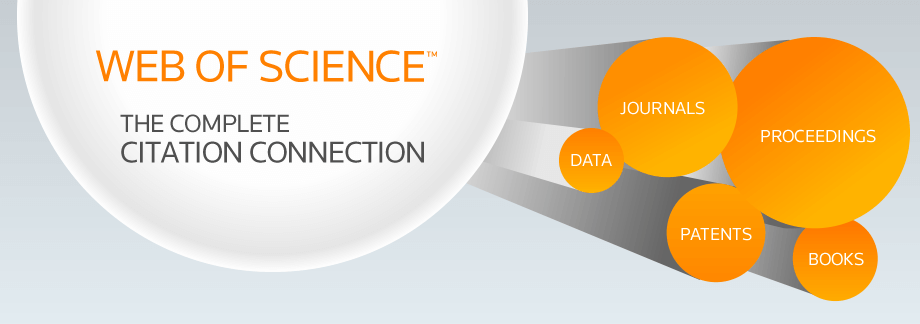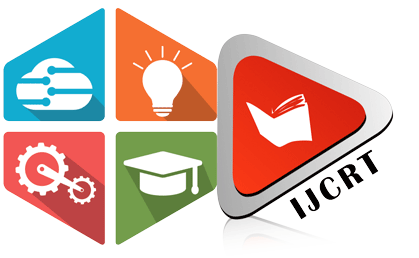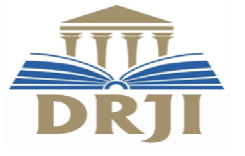INTERNATIONAL JOURNAL OF CREATIVE RESEARCH THOUGHTS - IJCRT (IJCRT.ORG)
International Peer Reviewed & Refereed Journals, Open Access Journal
IJCRT Peer-Reviewed (Refereed) Journal as Per New UGC Rules.
ISSN Approved Journal No: 2320-2882 | Impact factor: 7.97 | ESTD Year: 2013
Call For Paper - Volume 13 | Issue 10 | Month- October 2025
Scholarly open access journals, Peer-reviewed, and Refereed Journals, Impact factor 7.97 (Calculate by google scholar and Semantic Scholar | AI-Powered Research Tool) , Multidisciplinary, Monthly, Indexing in all major database & Metadata, Citation Generator, Digital Object Identifier(CrossRef DOI)
Contact Us Click Here
WhatsApp Contact Click Here
Volume 12 | Issue 3
| IJCRT Journal front page | IJCRT Journal Back Page |
Paper Title: APPETITE RECOMMENDATION SYSTEM THROUGH EMOTIONS
Publisher Journal Name: IJCRT
Your Paper Publication Details:
Published Paper ID: - IJCRT2403386
Register Paper ID - 248411
Title: APPETITE RECOMMENDATION SYSTEM THROUGH EMOTIONS
Author Name(s): Dr. A. Swathi, Neeli Sai Varshith, Anusha Pullela, Palangthod Tarun, Bhavani Muddam Padilam Srikanth
Publisher Journal name: IJCRT
Volume: 12
Issue: 3
Pages: d216-d228
Year: March 2024
Downloads: 262
Abstract
By Utilizing machine learning algorithms, our project presents an innovative approach to predict food choices based on user mood. The system employs the k-means clustering algorithm, an unsupervised learning technique, to create distinct clusters representing moods such as sad, happy, and stressed. Training our system with different data sets, including facial expressions, food reviews, and restaurant information, optimizes the efficiency of mood-based food predictions. The user-friendly interface of our system offers two mood selection options. Users can manually choose their current mood from predefined categories and the other one is by using webcam-based mood detection, where the system captures and analyzes user emotion expressions to predict food choices. The program's front end is designed with Bootstrap, while the back end is implemented using Python and the Flask framework. To enhance the accuracy of food predictions based on user mood, the system integrates facial expression recognition technology. The primary objective of our project is to provide users with user-friendly interaction that makes them helpful while decision-making. Anticipating a 70-plus accuracy rate, this innovation demonstrates the system's commitment to leveraging advanced technologies for mood-based recommendation precision. Our project is of personalized recommendation systems, leveraging advanced technologies to enhance user satisfaction in the realm of food choices based on their current mood. The combination of machine learning algorithms, a user-friendly interface, and innovative features positions your project as a pioneering effort in this domain.
Licence: creative commons attribution 4.0
License
Keywords
K-Means Clustering, Sentiment Analysis, Facial Emotion Recognition, Convolution Neural Network (CNN), NLTK.
License
Paper Title: Application Of Nano Robot In Medicin
Publisher Journal Name: IJCRT
Your Paper Publication Details:
Published Paper ID: - IJCRT2403385
Register Paper ID - 250347
Title: APPLICATION OF NANO ROBOT IN MEDICIN
Author Name(s): Nishat Makbulkhan Pathan, Maitreya Bhatkar, Rutika Barathe, Sakshi Kakade, Sakshi Labade
Publisher Journal name: IJCRT
Volume: 12
Issue: 3
Pages: d201-d215
Year: March 2024
Downloads: 227
Abstract
Nanorobots, an innovative and developing technology that combines robotics and nanotechnology, has great potential for revolutionising the medical industry. These tiny, self-contained machines, which are generally nanoscale in size, have the potential to precisely move through the human body, carrying out specific functions and dispensing medicines at the cellular and molecular levels. An overview of nanorobot applications in medicine is given in this abstract, with a focus on how they have the potential to revolutionise healthcare. Nanorobots are capable performing a wide range of tasks, including tissue regeneration, medication delivery, diagnosis, and surgery. They can be made to transport therapeutic agents or payloads of medications, enabling targeted, localised illness therapy. Drugs are delivered to the damaged location with the least amount of systemic adverse effects thanks to their capacity to travel through the circulation or enter tissues. Nanorobots with sensors and imaging equipment can diagnose illnesses quickly and with great precision by spotting their early symptoms. Nanorobots can reach difficult anatomical areas and execute minimally invasive treatments, considerably enhancing surgical techniques. They have the capacity to lessen patient suffering, healing time, and complication danger. Nanorobots can also help with tissue healing by moving and assembling biological components at the cellular level, which encourages regeneration processes. Nanorobots provide focused treatments and therapies in personalised medicine, providing promise for the treatment of diseases including cancer, neurological problems, and hereditary abnormalities. They have the potential to improve therapeutic effectiveness and lessen side effects by molecularly customising treatments. The creation and incorporation of nanorobots into clinical practise nevertheless face difficulties, despite these fantastic prospects. These concerns span a variety of areas, including as biocompatibility, power supply, safety, and navigation control. For nanorobots to be used safely and productively in healthcare, it is imperative that these issues be resolved
Licence: creative commons attribution 4.0
License
Keywords
Nanorobots, Nanotechnology, Cancer Treatment, Surgery, Medicine,Healthcare, Gene Therapy,Component, Nano-surgery, Disease Management
License
Paper Title: Malignant Conjunctival Melanoma Developed On Primary Acquired Melanosis Of The Conjunctiva : A Case Report
Publisher Journal Name: IJCRT
Your Paper Publication Details:
Published Paper ID: - IJCRT2403384
Register Paper ID - 252784
Title: MALIGNANT CONJUNCTIVAL MELANOMA DEVELOPED ON PRIMARY ACQUIRED MELANOSIS OF THE CONJUNCTIVA : A CASE REPORT
Author Name(s): TEBAY NADAA, Hazil Zahira, Krichene Mohamed Amine, Serghini Louai, Abdallah Elhassan
Publisher Journal name: IJCRT
Volume: 12
Issue: 3
Pages: d194-d200
Year: March 2024
Downloads: 223
Abstract
Conjunctival melanoma is a rare malignant melanocytic tumor with a bad prognosis due to its recurrence and metastatic potential. Conjunctival melanomas "de novo" or occuring on a nevus have a better prognosis than melanomas associated with primary acquired melanosis, which is a major risk factor for local recurrence and metastatic spread. We report the case of a 51-year-old patient with no particular history who consulted for the first time for a swelling of the inner canthus of the left eye and whose excisional biopsy was in favor of a conjunctival melanoma developed on primary acquired melanosis of the conjunctiva, and who had initially benefited from conservative surgery with external radiotherapy followed by secondary exenteration due to a voluminous endo-ocular recurrence during follow-up.
Licence: creative commons attribution 4.0
License
Keywords
Conjunctival melanoma, primary acquired melanosis, recurrence, conservative treatment, exenteration
License
Paper Title: Virtual Mouse And Keyboard Using Hand Gestures
Publisher Journal Name: IJCRT
Your Paper Publication Details:
Published Paper ID: - IJCRT2403383
Register Paper ID - 252940
Title: VIRTUAL MOUSE AND KEYBOARD USING HAND GESTURES
Author Name(s): Khushi Pathak, Aniket Joshi, Aryan Kalra, Shraddha Patil, Rajendra Babar
Publisher Journal name: IJCRT
Volume: 12
Issue: 3
Pages: d187-d193
Year: March 2024
Downloads: 201
Abstract
In-depth analysis and investigation of a Virtual Mouse and Keyboard system operated by hand gestures are the focus of this research paper .In the field of human-computer interaction, the development of input devices needs to be user-friendly and effective. This paper provides a new approach to build a virtual mouse using pyAutoGUI, OpenCV, Mediapipe and other cutting-edge technologies, as well as mathematical techniques. The goal is to offer a new way of operating a computer interface that will be especially useful for users who have difficulty moving around or need more control over the computer interface. MediaPipe is used for hand-finger following and allows for real-time positioning of signals as well as development designs. OpenCV can be used as a comprehensive multipurpose system for picture preparation and control. PyAutoGUI is a Python-based robotization module that automatically changes over hand gestures to simulate mouse activities on the screen. This examination highlights the potential to combine these innovations to create a more comprehensive, open computing environment that can cater to a wider range of clients and open up new conceivable outcomes for human-computer interactions.
Licence: creative commons attribution 4.0
License
Keywords
Virtual Mouse and Keyboard, Hand Gestures, Human-Computer Interaction
License
Paper Title: RESEARCH STUDY ON ANLYSIS OF PERFORMANCE OF EXCHANGE TRADING FUND WITH EQUTY MUTUAL FUND
Publisher Journal Name: IJCRT
Your Paper Publication Details:
Published Paper ID: - IJCRT2403382
Register Paper ID - 252771
Title: RESEARCH STUDY ON ANLYSIS OF PERFORMANCE OF EXCHANGE TRADING FUND WITH EQUTY MUTUAL FUND
Author Name(s): Sandeep kumar singh, Manpreet Sandhu, Anil kumar
Publisher Journal name: IJCRT
Volume: 12
Issue: 3
Pages: d180-d186
Year: March 2024
Downloads: 164
Abstract
: In recent years, the Indian ETF market has experienced notable expansion and development. ETFs gained traction after their 2001 launch, especially with products such as Gold ETFs. But in 2013, budgetary reforms that lowered transaction taxes and increased the participation of ETFs in pension funds marked a turning point. ETFs used by the government to sell its stake in public sector companies accelerated asset growth and investor awareness. By 2018, the market was dominated by other ETFs, mostly in the equities space, which accounted for a significant amount of all ETF assets. ETFs provide advantages over mutual funds, such as flexibility in trading and efficient operations. This development highlights how ETFs are becoming more and more significant in the Indian investing scene.
Licence: creative commons attribution 4.0
License
Keywords
Capital market Investors Businesses Exchange-traded funds (ETFs), Bonds, Mutual funds, Stocks Investment ,
License
Paper Title: Hindu Law Visionary: Dr. B. R. Ambedkar
Publisher Journal Name: IJCRT
Your Paper Publication Details:
Published Paper ID: - IJCRT2403381
Register Paper ID - 252863
Title: HINDU LAW VISIONARY: DR. B. R. AMBEDKAR
Author Name(s): Mona Goel, Navjot Kaur, Jasdeep Kaur
Publisher Journal name: IJCRT
Volume: 12
Issue: 3
Pages: d175-d179
Year: March 2024
Downloads: 188
Abstract
Dr. B. R. Ambedkar is well known for his efforts as a fighter and a scholar to bring liberty, equality and awareness in Indian society regarding various social and legal matters. Various scholar regard Dr. Ambedkar as a feminist by heart. In the early 19th century, world at large witness a specific reformed movement in favour of women in which prominent figures such as Raja Ram Mohan Rao, along with Mritunjay Vidayalankar tried to drew the attention of the society towards wretched conditions. Dr. B. R. Ambedkar was the first ever Indian who tried to brought justice and equality for women under the umbrella of law rather than in air. The major step taken by him can be seen in the codification of Hindu code which bring the concrete and sincere efforts in Hindu personal laws, which provides women equal rights in various civil matters from marriage rights to adoption and from adoption to succession. Dr. B. R. Ambedkar conceptualize a gynocentric society, wherein patriarchal norms are subverted. Ambedkar recognized the impact of caste patriarchy, caste position, and internal Dalit patriarchy on Dalit women. Keeping in mind the importance of women in the society despite of their caste, Dr. Ambedkar by the way of various speeches try to make the people understand that the true equality and liberty lies in equal opportunities for all i.e., for both men and women. This research paper will focus on the efforts made by Dr. Ambedkar for the shaping of the Hindu code and his views on women's problems in pre- and post-independent India.
Licence: creative commons attribution 4.0
License
Keywords
women, rights, Hindu code, equality, women empowerment
License
Paper Title: Web Impact Factor and Link Analysis of State Government Universities in Madhya Pradesh
Publisher Journal Name: IJCRT
Your Paper Publication Details:
Published Paper ID: - IJCRT2403380
Register Paper ID - 252842
Title: WEB IMPACT FACTOR AND LINK ANALYSIS OF STATE GOVERNMENT UNIVERSITIES IN MADHYA PRADESH
Author Name(s): Dr. Binu Mehrotra
Publisher Journal name: IJCRT
Volume: 12
Issue: 3
Pages: d162-d174
Year: March 2024
Downloads: 167
Abstract
Webometric is measuring the the websites, webpages, Parts of Webpages, words in webpages, link structure, web search engine results. This study examines 24 state Government Universities of Madhya Pradesh. Investigate Domains distribution of websites, analyse number of webpages and link pages and calculate the Self-link web impact factor, External link web impact factor and Revised web impact factor for state Government Universities in Madhya Pradesh and Rank the websites as per the WIF.
Licence: creative commons attribution 4.0
License
Keywords
State Government University, websites, Madhya Pradesh, website Analysis, Link Analysis, Internal link, External link, Backlink, Web Impact Factor.
License
Paper Title: Multi-Disease Prediction
Publisher Journal Name: IJCRT
Your Paper Publication Details:
Published Paper ID: - IJCRT2403379
Register Paper ID - 252851
Title: MULTI-DISEASE PREDICTION
Author Name(s): Peddinti Vijaya Durga, Pinisetti Likitha Naga Sri, Pinninti Pranusha, Pirikiti Venkata Gayathri, Polana Keerthi
Publisher Journal name: IJCRT
Volume: 12
Issue: 3
Pages: d154-d161
Year: March 2024
Downloads: 188
Abstract
Artificial intelligence (AI) is progressively reshaping medical practice, leveraging advancements in digitized data acquisition, machine learning, and computing infrastructure. Previously exclusive to human experts, AI applications now permeate diverse biomedical domains. This Review Article delineates recent AI breakthroughs, their biomedical implications, challenges hindering further progress in medical AI systems, and the economic, legal, and social ramifications of AI in healthcare. Our approach incorporates Python, benefiting from its extensive array of freely available packages spanning various domains. Key scientific Python libraries, including NumPy, SciPy, and pandas, offer efficient implementations of numerical operations, catering to common scientific and engineering tasks. These libraries provide a robust foundation for developing advanced scientific software without delving into low-level algorithms. Furthermore, domain-specific packages tailored to meteorological requirements supplement our methodology. Leveraging Convolutional Neural Networks, we classify diverse diseases alongside state-of-the-art Machine Learning algorithms.
Licence: creative commons attribution 4.0
License
Keywords
Machine Learning, Convolutional Neural Networks(CNN), Random Forest.
License
Paper Title: Machine Learning in Cybersecurity: Harnessing AI for Defense
Publisher Journal Name: IJCRT
Your Paper Publication Details:
Published Paper ID: - IJCRT2403378
Register Paper ID - 252813
Title: MACHINE LEARNING IN CYBERSECURITY: HARNESSING AI FOR DEFENSE
Author Name(s): Anwar Hossain, Roise Uddin, Abdus Sobur, Biswajit Chandra Das
Publisher Journal name: IJCRT
Volume: 12
Issue: 3
Pages: d146-d153
Year: March 2024
Downloads: 179
Abstract
The escalating cost of cyberattacks demands a paradigm shift in cybersecurity strategies used by organizations. Traditional methods, often reactive and data-limited, struggle to keep up with the ever-growing sophistication of cyber threats and the vast volumes of data organizations produce. That's why the use of cutting-edge technologies such as Artificial Intelligence (AI) and Machine Learning (ML) if crucial to preventing cyberattacks in this day and age. By leveraging AI and ML, organizations can analyze massive datasets in real-time, identifying subtle patterns and anomalies indicative of imminent attacks. This proactive approach shifts the focus from simply reacting to breaches to predicting and preventing them altogether. AI and ML also enable the automation of time-consuming tasks, which gives security teams more time to focus on strategic initiatives and tasks that require critical thinking. AI and ML algorithms also go beyond detecting known threats as they can effectively detect and combat the newest malware variants. Despite the many benefits of integrating AI into security tools, security teams need to carefully consider its ethical and technical challenges. Addressing these challenges requires adopting practices such as using diverse and high-quality data for effective training and ensuring the interpretability of complex models. Additionally, navigating the legal and ethical landscape surrounding data privacy and governance regulations is essential. The use of AI and ML in cybersecurity is even more critical today as we are now in the era of generative AI, which enables attackers to create more realistic phishing attacks [6]. Organizations need to devise ways to counter such attacks by using AI more effectively and aggressively than the attackers [6]. The purpose of this paper is to explore how organizations can harness the power of AI and ML to enhance their cybersecurity defenses. We aim to provide a comprehensive overview of how these advanced technologies can be utilized to fortify cyber defenses, analyze their strengths and weaknesses, and the best practices to get the best out of them.
Licence: creative commons attribution 4.0
License
Keywords
Increasing Artificial Intelligent, Protection for Cybersecurity, Enhancing AI, AI and ML
License
Paper Title: A Study on Optimization Conditions for Biodegradation of Methyl Orange Azo Dye Using Pseudomonas aeruginosa
Publisher Journal Name: IJCRT
Your Paper Publication Details:
Published Paper ID: - IJCRT2403377
Register Paper ID - 252801
Title: A STUDY ON OPTIMIZATION CONDITIONS FOR BIODEGRADATION OF METHYL ORANGE AZO DYE USING PSEUDOMONAS AERUGINOSA
Author Name(s): Vikalp Kumar, Shehwaz Anwar, S. Vijaya Prabhu, Ehsan Ahmed Yahia, Ravindra Raut
Publisher Journal name: IJCRT
Volume: 12
Issue: 3
Pages: d133-d145
Year: March 2024
Downloads: 148
Abstract
Licence: creative commons attribution 4.0
License
Keywords
Methyl Orange; Pseudomonas aeruginosa; Bacterial Degradation; Wastewater
License
Paper Title: The Suppression of Female Liberty in Arabic Literature
Publisher Journal Name: IJCRT
Your Paper Publication Details:
Published Paper ID: - IJCRT2403376
Register Paper ID - 252916
Title: THE SUPPRESSION OF FEMALE LIBERTY IN ARABIC LITERATURE
Author Name(s): QUDAMA KHAMEES HAMMOOD, DR. VIDYA RAO
Publisher Journal name: IJCRT
Volume: 12
Issue: 3
Pages: d125-d132
Year: March 2024
Downloads: 141
Abstract
Abstract The status and situation of women in the Arab world has become a synonym with the word oppression. Sexism is prevalent, dominant and embedded in the Arab culture over a millennia. So much so that, misogyny, male chauvinism and objectification have become an intrinsic part of the Arab way of life. Authors Leila Aboulela, Hanan al Shaykh and Fadia Faqir have weaved stories that are inspired, and at times, depict true events. Some incidents have been experienced either by the authors themselves, or others, who they knew or were acquainted with. The depiction of the life of protagonists is very relatable to the women in the Arab world. And through their novels, the authors have brought to light the plight, discrimination and the inhumane treatment that is meted out to women. Unfortunately, the perpetrators are either male family members or the justice system that denies women any chance of being treated equal to men. Even with the odds stacked against them, the women, through their innate courage, endeavour to break free from the shackles of enslavement at the cost of risking their lives. The authors have created characters who are compelled to act out of their desire to be free from bondage and live their lives in peace a birth right that is denied to them, by bigoted men and a culture that is abusive, in every sense of the word
Licence: creative commons attribution 4.0
License
Keywords
Keywords: misogyny, chauvinism, sexism, culture, women, realism
License
Paper Title: Fusion In Fashion - Transform Recycle Fabric Into Trendy Clothing
Publisher Journal Name: IJCRT
Your Paper Publication Details:
Published Paper ID: - IJCRT2403375
Register Paper ID - 252909
Title: FUSION IN FASHION - TRANSFORM RECYCLE FABRIC INTO TRENDY CLOTHING
Author Name(s): Preeti Bhatt, Manya Bhatt
Publisher Journal name: IJCRT
Volume: 12
Issue: 3
Pages: d114-d124
Year: March 2024
Downloads: 175
Abstract
Fusion in Fashion: Fusion, the amalgamation of diverse elements into a unified entity, has significantly transformed the Indian fashion landscape. The rise of fusion wear has ushered in a new era where contemporary styles seamlessly merge with vintage charm, giving rise to Indo-western fashion trends. This innovative approach to fashion blends elements from different cultures, incorporating Western silhouettes with traditional Indian textiles and styling. Fusion wear has gained widespread popularity, appealing to people across various social classes and age groups. One of the recent trends in sustainable fashion involves the use of recycled materials, which have become valuable commodities in the global market. Recycling not only holds financial significance but also contributes significantly to environmental preservation. Transforming recycled fabrics into trendy clothing items and creating vibrant designs with innovative styles exemplifies a fusion in fashion. This practice not only showcases creativity but also plays a vital role in conserving limited natural resources. Recycling has proven to be a success story, yet there is still much more that can be done to further enhance sustainability in the fashion industry. This article aims to promote awareness about sustainable fashion practices, emphasizing the importance of reusing waste clothes and inspiring new trends that contribute to a more eco-friendly and stylish future.
Licence: creative commons attribution 4.0
License
Keywords
Recycling, Recycling process, Waste Management, Practical workshop images, Advantages of recycling, Steps to reduce waste.
License
Paper Title: Crystallographic Nature and Textural Analysis on Copper Ferrites by Auto-combustion Technique
Publisher Journal Name: IJCRT
Your Paper Publication Details:
Published Paper ID: - IJCRT2403374
Register Paper ID - 252891
Title: CRYSTALLOGRAPHIC NATURE AND TEXTURAL ANALYSIS ON COPPER FERRITES BY AUTO-COMBUSTION TECHNIQUE
Author Name(s): Shwe Khine Pyone, Saw Shine Ko, Ko Ko Aung, Soe Soe Maw, Tun Aye
Publisher Journal name: IJCRT
Volume: 12
Issue: 3
Pages: d108-d113
Year: March 2024
Downloads: 195
Abstract
In this research work, Copper Ferrites (CuFe2O4) nanocrystalline powder with different calcination are synthesized from copper nitrate hexahydrate, Ferric Nitrate, Citric acid and chelating agent Ammonium hydroxide chemical precursors. Copper Ferrites nanocrystalline powder were fabricated by using sol-gel auto combustion technique. Crystallographic information, d-spacing and average crystallite size were characterized by X-Ray diffraction (XRD). The surface morphology and textural studies were examined by Scanning Electron Microscopy. The vibrational and functional group analysis of synthesized CuFe2O4 nanocrystalline powder by Fourier Transform mid-range Spectroscopy. The characteristics of synthesized CuFe2O4 nanocrystalline powder under above analysis information are economical and quite feasible for secondary electrode in Solid oxide fuel cells (SOFC) research field.
Licence: creative commons attribution 4.0
License
Keywords
Copper Ferrites, Auto-combustion, Calcination, XRD, SEM, FTIR
License
Paper Title: Multiple Sclerosis: Ayurvedic Approach
Publisher Journal Name: IJCRT
Your Paper Publication Details:
Published Paper ID: - IJCRT2403373
Register Paper ID - 252954
Title: MULTIPLE SCLEROSIS: AYURVEDIC APPROACH
Author Name(s): Dr. Anjali, Dr. Darshna Pandya
Publisher Journal name: IJCRT
Volume: 12
Issue: 3
Pages: d103-d107
Year: March 2024
Downloads: 200
Abstract
Introduction: Multiple sclerosis (MS) is an autoimmune demyelinating disease of central nervous system which can lead to various physical or cognitive disability as well as neurological defects. The global prevalence of MS was 35.9 per 100,000 people in 2020. In India it was regarded as a rare disease in past but marked surge in cases of the disease are observed in recent years. Like other autoimmune diseases exact aetiology and pathogenesis is not clear yet. However available data shows that causes of MS are multifactorial and include genetic predisposition together with environmental factors. Clinical features vary with the site of lesions. Most common symptoms are visual impairments, fatigue (Angamarda), tingling and numbness (Supti), muscle spasm (Udveshtana), stiffness (Angagraha) and weakness (Daurbalya), pain (various kinds of Vedana), depression and anxiety (Chittodvega / Chittavasada), cognitive impairment (Prana involvement), bladder control & bowel problems (Apana dysfunction), speech and swallowing problems (Prana - Udana dysfunction). Aim - To understand the different dimensions of MS in Ayurvedic parlance. Materials and methods - Modern standard textbooks of medicine, Ayurvedic classical texts and research articles related to present study were viewed to understand the disease MS. Result- MS should be studied under the label of Anukta Vyadhi since no direct description of the disease is available in Ayurvedic classics. On the basis of clinical presentation role of Vata vitiation is evident in development of MS. It can be correlated with different domains of Vatavyadhi depending on the presentation and pathology. As there is no cure of the disease in modern medicine, Ayurveda can provide much needed insights in improving quality of life of patients and providing better management.
Licence: creative commons attribution 4.0
License
Keywords
Multiple sclerosis, Demyelinating disorders, Ayurveda, Vatavyadhi
License
Paper Title: Quality-Aware Automatic ECG Arrhythmia Detection And Classification
Publisher Journal Name: IJCRT
Your Paper Publication Details:
Published Paper ID: - IJCRT2403372
Register Paper ID - 252887
Title: QUALITY-AWARE AUTOMATIC ECG ARRHYTHMIA DETECTION AND CLASSIFICATION
Author Name(s): V. Simhadri, S. Jaya Abhiram, Y. Suvarna Jyothi, K. Prasad, G. Sai Satya Sudheer
Publisher Journal name: IJCRT
Volume: 12
Issue: 3
Pages: d95-d102
Year: March 2024
Downloads: 207
Abstract
Electrocardiogram (ECG) arrhythmias are critical indicators of cardiac health, necessitating accurate and timely detection for effective clinical intervention. This paper proposes a novel approach for automatic ECG arrhythmia detection and classification, integrating quality-aware techniques to enhance accuracy and reliability. Leveraging Machine learning algorithms and signal processing methodologies, our system demonstrates promising results in identifying various types of arrhythmias while ensuring robustness against noise and artifacts. The proposed system offers potential applications in clinical settings for early diagnosis and intervention, thereby improving patient outcomes and healthcare efficiency.
Licence: creative commons attribution 4.0
License
Keywords
ECG, Arrhythmia Detection, Machine Learning, Signal Processing, Quality-Aware Techniques, Healthcare.
License
Paper Title: Tiles And Marbles E-commerce Inventory Management Through Sales Prediction
Publisher Journal Name: IJCRT
Your Paper Publication Details:
Published Paper ID: - IJCRT2403371
Register Paper ID - 252412
Title: TILES AND MARBLES E-COMMERCE INVENTORY MANAGEMENT THROUGH SALES PREDICTION
Author Name(s): Dr Priya Nandihal, Palanati Krishna Hanuman, Raman Singh, Rishav Kumar, Rohan Ashtaputre
Publisher Journal name: IJCRT
Volume: 12
Issue: 3
Pages: d84-d94
Year: March 2024
Downloads: 177
Abstract
This paper explores the intersection of predictive analytics and inventory management in the tiles and marbles e-commerce sector. Focused on developing an innovative sales prediction model, the study aims to revolutionize demand forecasting, optimize inventory levels, enhance marketing campaigns, and ultimately reduce costs. The investigation addresses the limitations of existing solutions, seeking to empower businesses with a tailored inventory management system to gain a competitive edge in this dynamic industry.
Licence: creative commons attribution 4.0
License
Keywords
Tiles and marbles E-commerce Inventory Management through Sales Prediction
License
Paper Title: Unfolding The Harsh Realities Of Part-Time Domestic Work: A Study Conducted Among The Female Domestic Workers Of Kerala
Publisher Journal Name: IJCRT
Your Paper Publication Details:
Published Paper ID: - IJCRT2403370
Register Paper ID - 252948
Title: UNFOLDING THE HARSH REALITIES OF PART-TIME DOMESTIC WORK: A STUDY CONDUCTED AMONG THE FEMALE DOMESTIC WORKERS OF KERALA
Author Name(s): SAI DEVI S
Publisher Journal name: IJCRT
Volume: 12
Issue: 3
Pages: d69-d83
Year: March 2024
Downloads: 230
Abstract
In India, women account for almost one-third of the working population. The majority of these women are employed in unorganized and informal sectors of the economy, such as construction, agriculture, and domestic labor. The bulk of workers in the domestic services sector are, in particular, women and young girls. The current study intends to empirically investigate the nature of labor interactions between paid domestic workers and their employers as perceived by the former. It attempts to take a closer look at the general working conditions of domestic workers as well as the issues and challenges they encounter on a daily basis. Further, the research aims to eventually examine how the life trajectories of female part-time, live-out domestic workers are built by focusing on their nature of employment arrangements and experiences in workplace conditions. The study largely contextualizes domestic work relations in India as a domain of continuing and ongoing power struggle, drawing extensively from feminist theory. Using in-depth, semi-structured interviews with fifteen female domestic workers from Kerala's Thiruvananthapuram district, the researcher sought to realistically illustrate how the world of domestic work still remains an extremely unequal, deeply structured, and intricately stratified terrain characterized by the intersecting hierarchies of caste, class, gender, and religion.
Licence: creative commons attribution 4.0
License
Keywords
Domestic worker, female, labor, gender, caste, class, discrimination
License
Paper Title: A REVIEW ON METHODS USED FOR PLANT VIRAL INFECTION
Publisher Journal Name: IJCRT
Your Paper Publication Details:
Published Paper ID: - IJCRT2403369
Register Paper ID - 252555
Title: A REVIEW ON METHODS USED FOR PLANT VIRAL INFECTION
Author Name(s): SARITA SHRINIWAS CHAVAN, SHRADDHA RAHUL CHAVAN, GITANJALI CHANDRAKANT CHAVAN, VISHAL GOVIND SAKHARE
Publisher Journal name: IJCRT
Volume: 12
Issue: 3
Pages: d56-d68
Year: March 2024
Downloads: 164
Abstract
The biggest danger to sustainable agriculture is plant viral infections, which can cause multiple losses. Numerous viruses are affecting a variety of crops, thus new methods that can accurately identify the causative agents of viral infections are more and more needed for their efficient treatment and prevention. Numerous diagnostic techniques that are more sensitive and specific in identifying unidentified plant viruses are constantly being researched and developed. Controlling plant viral infections requires an early and precise diagnosis of these infections. For purposes of assembly, reproduction, intra- and intercellular mobility, and attracting vectors for dispersal, viruses depend on their hosts. Several viruses require chloroplasts to replicate. A crucial part of plant physiology, photosynthesis, is hampered when viruses multiply in chloroplasts. Chloroplasts are present in plants which is very essential for the replication of viruses. Some viruses replicate in chloroplast. When viruses replicate in chloroplast they inhibit the photosynthesis process, which is a very important process in plant physiology. This viral infection reduces the quality of crop yield, stunts crop growth, and results in low-quality products. To overcome this condition or this viral infection in plants use different techniques like PCR and ELISA. Many techniques are effective and can provide accurate identification of the viral causative agent. There are continuously developed new techniques for the detection method of viruses present in plants which have improved sensitivity and specificity. Assays utilizing enzyme-linked immunosorbents (ELISA), are created using the serological approach and are routinely utilized. However, ELISA's capacity to identify plant viruses is limited by factors including the target virus's antibody availability and the length of time needed to conduct the ELISA. Originally designed as a method for amplifying target DNA, the polymer chain reaction (PCR) has evolved into numerous variants and is now more sensitive than ELISA. Numerous plant virus detection systems, including those based on immunological detection, PCR technology, and hybridization-based techniques like microarray, microscopic method, visual inspection method, dot stain immune binding assay nucleic acid-based method, etc. are described here
Licence: creative commons attribution 4.0
License
Keywords
Plant viral detection, Plant viruses, ELISA, PCR, Nucleic acid.
License
Paper Title: How to get a gun license in India
Publisher Journal Name: IJCRT
Your Paper Publication Details:
Published Paper ID: - IJCRT2403368
Register Paper ID - 252857
Title: HOW TO GET A GUN LICENSE IN INDIA
Author Name(s): Himanshu Singh
Publisher Journal name: IJCRT
Volume: 12
Issue: 3
Pages: d46-d55
Year: March 2024
Downloads: 795
Abstract
In a well - organised society, the responsibility for efficiently managing the nation, fostering societal development, and ensuring citizens have essential resources for survival lies with the State and the Government. Paramount tasks of the State include upholding law and order, preventing crimes, and safeguarding citizens from both internal and external threats. This is achieved through defence forces like the army and law enforcement agencies such as the police, which are authorised to use lethal force and weapons when necessary. These forces strategically, offensively, and tactically stay ahead of potential adversaries in their various operations. The term 'weapon' encompasses items such as guns, firearms, armaments, ammunition, and other defence equipment designed to cause destruction, damage, pain, or harm. These tools are typically associated with warfare, conflicts, crimes, defence, law enforcement, and hunting, among other purposes. Due to the State's responsibility for maintaining law and order, citizens are generally restricted from owning or possessing a firearm for any purpose. Laws in most countries regulate matters such as ownership, sale, manufacturing, transfer, modification, and use of firearms by civilians. These laws are often stringent to prevent violent crimes, shootings, murders, suicides, and, most importantly, to curb armed rebellions, insurgencies, and terrorist activities within the state. India, for instance, has stringent regulations regarding firearms governed by The Arms Act, 1959, supplemented by The Arms Rules, 2016. This legislation prohibits the sale, manufacture, possession, acquisition, import, export, and transport of firearms and ammunition without a licence. The current Arms Act, 1959, traces its origin back to The Indian Arms Act, 1878, enacted during British Rule after the Revolt of 1857. Thus, this paper aims to outline the types of guns that are illegal or prohibited to be acquired, the eligibility criteria to obtain a licence, the steps involved in acquiring a firearms licence, when could a licence be revoked or cancelled, what are the penalties for owning a firearm without licence, what is the current position of laws and a way ahead from the current scenario.
Licence: creative commons attribution 4.0
License
Keywords
The Arms Act (1959), The Arms Rules (2016), Indian Gun Ownership Laws, Firearm License Application Procedure, Types of Firearms, Prohibited Bore, Non - Prohibited Bore, Gun Permit Requirements, Firearm Licensing Authority, Steps to Obtain Gun License, Documentation for Gun License, Eligibility Criteria for Gun License, Consequences of Firearms Misuse, Section 25 of Arms Act (1959), Section 26 of Arms Act (1959), Section 27 of Arms Act (1959), Section 30 of Arms Act (1959), Suspension or Revocati
License
Paper Title: INDIGENOUS KNOWLEDGE OF MEDICINAL PLANTS IN RURAL AREAS OF MAHABUBNAGAR DISTRICT
Publisher Journal Name: IJCRT
Your Paper Publication Details:
Published Paper ID: - IJCRT2403367
Register Paper ID - 252817
Title: INDIGENOUS KNOWLEDGE OF MEDICINAL PLANTS IN RURAL AREAS OF MAHABUBNAGAR DISTRICT
Author Name(s): Amina Mumtaz Jahan, Qamar shajahan
Publisher Journal name: IJCRT
Volume: 12
Issue: 3
Pages: d41-d45
Year: March 2024
Downloads: 217
Abstract
This study aims to gather and document information on indigenous knowledge of medicinal plants used in rural areas of Mahabubnagar district of Telangana State. The survey identifies 40 species of 36 genera of medicinal plants belonging to 21 families by indigenous people in rural areas of Mahabubnagar district for the treatment of different illness. The indigenous knowledge of medicinal plants depends on the surrounding plants. During the process of civilization and urbanization many medicinal plant species have been lost. The majority of the medicinal plants are locally available and are cultivated by tribal and rural people. Leaves, flowers, fruits and roots are principal part of the plants used. The indigenous community of Mahabubnagar district such as konda reddy, koyas, nayak, savera, valmikies and vaideyas played an important role healing different diseases by using medicinal plants locally available. The indigenous knowledge of the medicinal plants of these ethnic people is mostly confined to older people. This knowledge is transferred to trial and error basis and still in use. The oral route was the most commonly used mode of administration of herbal medicine. Occimum sanctum, Aloe vera, Withania sonifera, Mucuna pruriens, Acorus calamus, Comiphora weighti, Veronia amygdalina, Cleodendron myricoides are most repeatedly claimed medicinal plants of these people. The indigenous knowledge of the medicinal plants should be restored and maintained, as this provides large data regarding the medicinal properties of plants not known to the modern men.
Licence: creative commons attribution 4.0
License
Keywords
medicinal plants, indigenous knowledge, tribal people, diseases, survey.
License
About IJCRT
The International Journal of Creative Research Thoughts (IJCRT) aims to explore advances in research pertaining to applied, theoretical and experimental Technological studies. The goal is to promote scientific information interchange between researchers, developers, engineers, students, and practitioners working in and around the world.
Indexing In Google Scholar, ResearcherID Thomson Reuters, Mendeley : reference manager, Academia.edu, arXiv.org, Research Gate, CiteSeerX, DocStoc, ISSUU, Scribd, and many more International Journal of Creative Research Thoughts (IJCRT) ISSN: 2320-2882 | Impact Factor: 7.97 | 7.97 impact factor and ISSN Approved. Provide DOI and Hard copy of Certificate. Low Open Access Processing Charges. 1500 INR for Indian author & 55$ for foreign International author. Call For Paper (Volume 13 | Issue 10 | Month- October 2025)
October 2025
Volume 13 | Issue 10
Last Date :
30-Nov-2025
Submit Manuscript Online Impact Factor: 7.97 Review Results : Within 02-03 Days Paper Publication : Within 02-03 Days

ISSN: 2320-2882 Impact Factor: 7.97 and ISSN APPROVED Journal Starting Year (ESTD) : 2013

ISSN: 2320-2882 Impact Factor: 7.97 and ISSN APPROVED Journal Starting Year (ESTD) : 2013

CONFERENCE PROPOSAL CONFERENCE PROCEEDINGS







































































